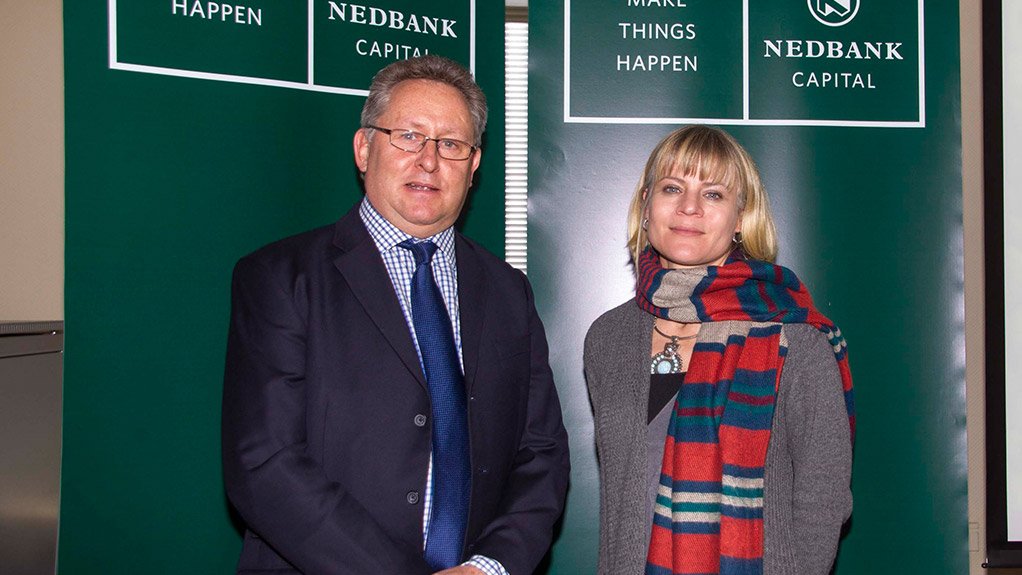It is critical that South Africa’s strategic infrastructure projects are prioritised and implemented by learning from successful programmes, such as the Renewable Energy Independent Power Producer Procurement Programme (REIPPPP), as the country’s economy continues to slide, in part, owing to persistent and significant infrastructure constraints.
Speaking on Tuesday at a Nedbank Capital media roundtable on infrastructure, Nedbank senior economist Nicky Weimar said the most broadly felt infrastructure constraint was the country’s insufficient and unreliable power supply, which was required to fuel higher growth levels.
“President Jacob Zuma’s recent State of the Nation speech highlighted the urgent need to address energy security, with the soon-to-be-formed Energy Security Cabinet subcommittee tasked to address all activities in the energy sector,” she said.
However, energy infrastructure was not the only form of economic infrastructure South Africa was lacking, as insufficient road, rail, port, communications and other logistical infrastructure had also proven hugely damaging to the economy.
Consequently, Weimar explained, these infrastructure constraints had driven the cost of production higher, partly contributing to a loss of international competitiveness among local producers and exporters, restricting fixed investment by private companies.
She said the drag on South Africa’s gross domestic product (GDP) from 2007 to 2014 had mostly come from producers in the mining sector, followed by the manufacturing industry. “The manufacturing industry is very much below par. Once the world economy started to recover [after the 2008 recession, so did manufacturing]. But it has been a slow and patchy recovery [and] we are still below the level we were before the recession.”
The sectors that “kept the wheels turning” were the services industries such as transport and communications, construction and finance and real estate.
“The South African Reserve Bank estimated that with our current economic infrastructure, the economy’s potential for growth is probably capped at around 3.5%, which is clearly insufficient if we are to adequately address unemployment, inequality or widespread poverty,” Weimar noted.
Nedbank Capital head of infrastructure, energy and telecoms Mike Peo, who also spoke at the media roundtable, added that gross fixed capital formation needed to reach about 30% of GDP by 2030, with public-sector investment reaching 10% of GDP, to realise a sustained impact on growth and household services.
However, he pointed out that the country’s worsening economic cycle had reduced the amount of funding that the fiscus had available for the development of economic infrastructure from the tax base, while simultaneously any downturns in the international rating of South Africa increased the cost of government borrowing.
“These two factors make it increasingly difficult to raise the money required to deliver on the strategic integrated projects (Sips),” Peo said, adding that the NDP made provision to leverage private sector involvement; however, the actual method as to how to achieve this was still relatively undefined.
NEGATIVE FOREIGN PERCEPTION
Weimar said the deterioration of general foreign investor sentiment towards South Africa was most recently demonstrated by the downward adjustment of sovereign ratings by Fitch and Standard & Poor’s.
“Frequent and devastating labour conflicts [such as the five-month-long strike in the platinum sector, which is finally coming to a close] combined with continued strained power capacity, had added to the disquiet, by continuing to generate large current [account] deficits,” she pointed out.
Prioritising the Sips identified in the National Development Plan (NDP), Weimar noted, would “undoubtedly have a much-needed positive effect on foreign perceptions of risk in South Africa”.
The next question, said Peo, was how to turn the NDP into action.
SOLVING THE BACKLOG
He noted public–private partnerships (PPPs) were capable of meeting most of the objectives set out in the NDP and that the success of the REIPPPP was a good starting point.
With 66 renewable-energy projects banked inside of 24 months, at a project value in excess of R150-billion, the programme could be “heralded as the most successful large-scale procurement programme ever undertaken between the private and public sector in South Africa”.
Peo noted that there was international precedent for the use of PPPs as major delivery platforms with regard to the development of large-scale infrastructure projects.
South Africa had a well-developed set of PPP regulations and standardised provisions and, historically, all projects developed by PPPs in South Africa had been constructed in time and within budget – with the private party assuming the risk of cost over runs, he said.
PPPs were the most effective mechanism for the transfer of risk, Peo stated, as it transferred risk to parties that were best suited to assume, price for and manage it, “generally ensuring that projects were completed in accordance with value for money and affordability parameters set by the State.”
PPPs also helped government leverage capacity of highly experienced project developers and financiers, while the private sector was generally willing and able to step in where government was constrained by capacity and the fiscus was limited in providing the spend needed on the balance sheet, he added.
EMAIL THIS ARTICLE SAVE THIS ARTICLE
To subscribe email subscriptions@creamermedia.co.za or click here
To advertise email advertising@creamermedia.co.za or click here













